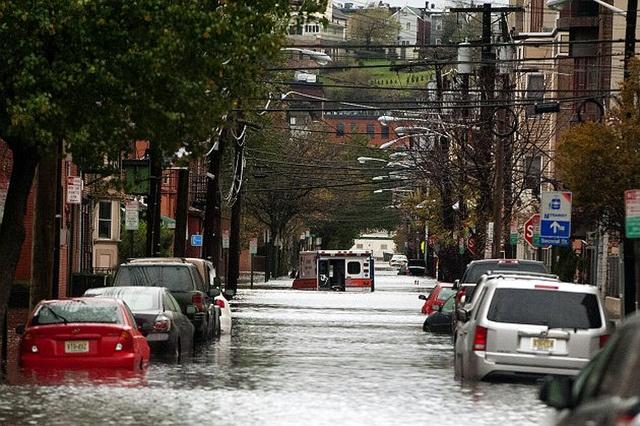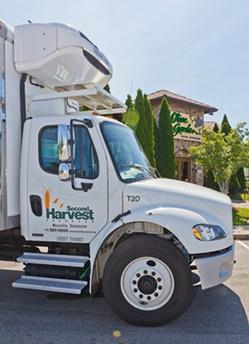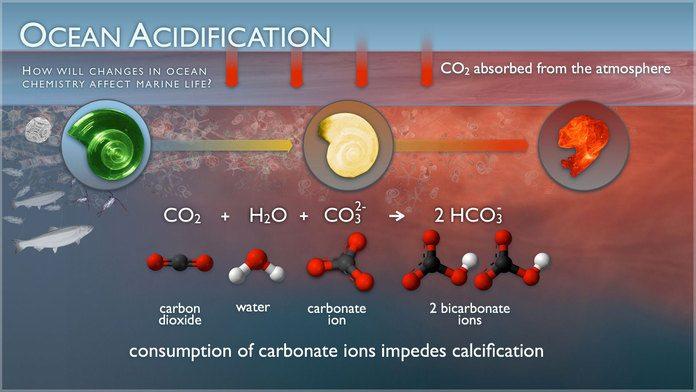Climate Change: Business Must Learn to See Future Uncertainty as Opportunity


James Goodman, Forum for the Future
If you think it’s hard to attribute a flood, a drought or a storm to climate change, try a banking crisis, a social movement or even a war. These are the kinds of consequences that the second part of the IPCC’s fifth assessment report, released on Sunday, alludes to. In amongst the analysis of "observed impacts" and "future risks" was this insight:
“Understanding future vulnerability, exposure, and response capacity of interlinked human and natural systems is challenging due to the number of interacting social, economic, and cultural factors, which have been incompletely considered to date.”
They list factors such as: “wealth and its distribution across society, demographics, migration, access to technology and information, employment patterns, the quality of adaptive responses, societal values, governance structures, and institutions to resolve conflicts.” Understanding how climate change alters the rules of the game right across the board will be key to prospering in the years to come.
Climate models are the obvious place to start to understand the implications of climate change, but they are still gross simplifications of a planet full of interconnecting systems, of which the climate system is just one part. They can’t tell us what it will be like to live in the future -- they just tell us what the weather might be like.
The best way of understanding life in the future is to develop scenarios that tell stories about the different possible futures that could emerge – based on long-term trends, emerging patterns of change, and the choices that people make today and in the future. Not narrowing uncertainty by trying to predict, but empowering people to see future uncertainty as opportunity.
Our work with the tea industry shows how this can work in practice. Tea 2030 has brought together companies big and small as well as a range of other critical organizations, we have explored a number of different scenarios for the future of tea, how it could be grown, processed, distributed and consumed, responding to the challenges of climate change, water scarcity and a host of other factors. The conversations have led us as a group to come up with a set of principles the tea sector should follow, and actions that must be taken to secure a sustainable future.
Similar conversations about the future inspired our Glocal project with Ecover on the island of Mallorca. It’s an experiment in building a local, closed loop business model for cleaning products, one that will continue to deliver value in a resource-constrained future.
While it seems a bit crass to suggest, particularly given the massive human suffering being caused right now and which is inevitable in the future, there is a silver lining to the climate change crisis. Climate change is shaking up the systems we rely on for our wellbeing and disruption at this scale opens up huge opportunities for business to create long term value for people in a way that protects or – better – rebuilds our natural capital. Perhaps the next thing to be attributed to climate change will be the start of a business revolution.
Image credit: Flickr/accarrino
James is Director of Futures at Forum for the Future. His role involves working with leading global companies, such as Unilever and Pepsico, to imagine sustainable future business, or with industries such as dairy, retail or the shipping industry to transform entire industries to function more sustainably.
Shocker: 89 Percent of Fast Food Workers are Victims of Wage Theft


As if it's not enough that so many minimum wage workers can't make ends meet on an honest day's work, many also find themselves performing work for free or less than they're due. A new poll conducted by Hart Research Associates shows an overwhelming majority of fast food workers, 89 percent, have experienced wage theft.
Low-wage employers' conniving ways to avoid fair pay for honest work is the general rule, not the exception. McDonald's franchise employers, for example, are facing lawsuits for these types of practices, as they exploit corporate-provided computer systems to doctor their workers hours so they can avoid paying overtime, or to make it seem like employees took breaks they worked through instead. Time worked, but not compensated.
In fact, I seem to recall experiencing it when I was a naive, eager-to-please kid. At the age of 16, I nervously jittered through my very first job interview at a major steakhouse chain. The manager monotonously gestured around the restaurant to indicate what my duties as a dishwasher might be if I were hired. He showed me where folks clocked in and clocked out and then said: "Oh...would you be taking breaks? You're supposed to get like a 15 minute break, but nobody here takes those."
"Uh...no?" I stuttered.
"Okay. Yeah, nobody takes those. Just give me your timecard instead of punching out, and I'll take care of that part. So when can you start?"
I didn't think much then of the notion that my employer would be doctoring my timecards to make it seem like I worked 15 minutes less than I did each day. I was a nervous kid. But it was pretty overt wage theft.
Restaurants are close knit quarters, and you're actively cooperating with other employees for hours and hours, day after day. Peer pressure can be pretty intense. And you also don't want to let your co-workers down when things get busy or you're somehow short-staffed. And too often, employers prey on that sense of fraternity, or sense of loyalty to the employer, to squeeze a little more unpaid time out of the worker.
So lets get back to that new poll showing that a monumental 89 percent of workers in the fast food industry have experienced wage theft. Just to be clear, wage theft is illegal.
The most common form of wage theft is off-the-clock work -- the sort of thing that happened when I had my first job. According to the poll, 43 percent of employees were denied breaks during long hours. Employers can doctor the times of the employees to make it seem like they've taken breaks when in fact they haven't. So...employees don't get a break and work instead, and then don't get paid for that time. One McDonald's manager, Kwanza Brooks, recounts, “I had a manager that actually sat with me when I was closing, and when it was time to shut down the system, the exact words were, ‘Oh, we’ve gotta adjust labor.’” She continued: “See what you would do is at the end of the shift, as a manager, you constantly have to go into the computer, and you’re going to put that break in there if the time is not balancing out. I on several occasions had employees come and work either before their shift or stay after their shift.”
A video produced by the organization Low Pay is Not Okay highlights how franchise owners and operators used corporate-provided computer systems to manipulate employees' hours. This computer system is the central focus of a lawsuit filed by McDonald's workers.
Another common form of wage theft is to not properly compensate employees for time they've worked beyond 40 hours in a week. The poll finds that, "48 percent of workers who have worked more than 40 hours in a single week (26 percent of all fast food workers) say that they do not always receive the overtime pay that they are owed."
Here is a full accounting of types of wage theft and how common they are, as found by the poll:
- 60 percent of workers have been required to perform tasks before clocking in or after clocking out.
- 46 percent have not been paid for all hours worked or all tasks performed.
- 43 percent were not allowed a break every time they worked a shift of 6+ hours.
- 40 percent have had the cost of uniform items deducted from their paychecks.
- 38 percent have received their paychecks late or been asked to wait a day or more before cashing them.
- 32 percent have had to pay their employer if the register was short.
- 26 percent do not always receive overtime pay of time-and-a-half when working more than 40 hours/week
- 21 percent have had meals that they have not eaten deducted from their paychecks.
- 15 percent have had the cost of missing items from the restaurant deducted from their paychecks.
- 13 percent have received all or part of their paychecks in cash.
- 9 percent have had their paychecks bounce.
- 9 percent have not been reimbursed for insurance while making deliveries.
- 8 percent have not been reimbursed for gas while making deliveries.
TriplePundit covered a similar story about a $9 billion wage theft lawsuit filed against major Silicon Valley employers, such as Apple and Google. Silicon Valley companies allegedly engaged in illegal agreements to not hire employees away from each other, resulting in depressed wages for high-demand employees.
Wage theft is exceedingly common. And it's illegal. It's not enough that low-wage employees are trying to scrape by on minimum wage in exchange for honest work. But they're also getting aggressively cheated out of even that ... No money at all for hours worked as major employers find loopholes and employees are too worried about their job security to speak out.
Image credit - AdamL212 - Source
Unilever's Lifebuoy campaign achieves dramatic results


Incidences of diarrhoea have dropped from 36% to just 5% in the Indian village of Thesgora as a direct result of Unilever’s soap brand Lifebuoy’s ‘Help a Child Reach 5’ handwashing programme.
The decrease in this village – known for having one of the highest rates in India of this deadly yet preventable disease – was observed over the period of Lifebuoy’s intervention in an independent evaluation of 1485 households with children aged below 12 years, conducted by Nielsen in September 2013.
Lifebuoy’s ‘Help A Child Reach 5’ campaign aims to eradicate preventable deaths from diseases like diarrhoea through teaching lifesaving handwashing habits.
Lifebuoy’s handwashing programmes are now being rolled out to villages across 14 countries (Bangladesh, Brazil, Egypt, Ghana, India, Indonesia, Kenya, Malaysia, Nigeria, Pakistan, South Africa, Sudan, Uganda and Viet Nam) and scaled up in India to reach 45 million people.
Later this month, the Unilever Sustainable Living Report 2013 will be published, which the company says will confirm that it has reached around 303 million people through its programmes of handwashing, safe drinking water, oral health and self-esteem.
GSK to create world's first R&D Open Lab in Africa


Pharma giant GSK is to invest £25m to create the world's first R&D Open Lab for non-communicable diseases (NCDs) in Africa.
The centre will see GSK scientists collaborate with research and scientific studies across Africa from its UK R&D hub and conduct epidemiological, genetic and interventional research to increase understanding of NCDs in the continent. An independent governing board of leading scientists and clinicians will oversee the implementation of the research projects.
The open lab aims to improve understanding of NCD variations seen in Africa, for example the apparent higher prevalence of treatment-resistant hypertension and aggressive breast cancers in younger women.
The news follows an announcement by GSK ceo, Sir Andrew Witty, on Monday which set out the company's plans significantly increase its presence in Africa. It is to build five new factories, representing an investment of around £100m, as well establish 25 academic Chairs at African universities to support development of local skills. Its new strategic investment also includes a commitment to train an additional 10,000 community healthworkers across sub-Saharan Africa.
UK government to turn rooftops into solar power stations


Plans to turn the Government estate as well as factories, supermarkets and car parks into “solar hubs” have been outlined in a new strategy by Energy Minister Greg Barker.
The Solar Strategy, the first of its kind in the UK, sets out the Government's ambition to see solar rolled out more widely and with it the potential to support tens of thousands of jobs.
Launching the Solar Strategy at SunSolar Energy in Birmingham, Energy Minister Greg Barker said: “We have put ourselves among the world leaders on solar and this ambitious strategy will place us right at the cutting edge.
“Solar not only benefits the environment, it will see British job creation and deliver the clean and reliable energy supplies that the country needs at the lowest possible cost to consumers.
"We want to move the emphasis for growth away from large solar farms and instead focus on opening up the solar market for the UK’s estimated 250,000 hectares of south facing commercial rooftops. Solar increasingly offers efficient and cost effective onsite generation opportunities to both businesses and domestic consumers, and our strategy makes a step change in our ambition for both. as a means to generate renewable energy."
The government maintains that widespread solar will ensure a better deal for consumers and help move towards a greener, more local energy sector.
Picture courtesy: © Remigiusz Oprzadek | Dreamstime Stock Photos
Interview: Brandon Tidwell on Darden Restaurants' 2013 Citizenship Update


Earlier this year, Darden Restaurants, the Fortune 500 restaurant giant known for brands like Red Lobster and Olive Garden, released its 2013 Citizenship Update — which includes some pretty impressive numbers related to sustainability, culture and corporate social responsibility (CSR). With its latest report, the world’s largest full-service restaurant operator is making it clear that sustainability is a priority.
Thanks to efforts that have been in place since 2009, Darden achieved its water reduction goal of 15 percent per-restaurant two years early. The company also plans to shrink energy use by 15 percent per-restaurant by 2015 (compared to a 2008 baseline), which it is well on the way to achieving with a 12.3 percent drop as of last year, according the update.
As of 2013, the company's Darden Harvest program — which sends fresh food that isn't served to community food banks across the U.S. and Canada — has donated more than 66 million pounds of food with a fair market value of nearly $600 million since its inception in 2004. The company is also making waves in sustainable seafood sourcing, an increasingly important issue as ocean health concerns mount. Last year Darden bought 100 percent of its shrimp, 85 percent of its salmon, and 80 percent of its tilapia and catfish according to Global Aquaculture Alliance Standards.
3p sat down with Brandon Tidwell, manager of sustainability for Darden Restaurants, to talk about the latest Citizenship Update and where the company is headed when it comes to sustainability.
TriplePundit: The Darden Harvest program is one of your oldest sustainability programs, and the company recently surpassed 66 million pounds of food donations. What can you tell us about how the program is going?
Brandon Tidwell: The program continues to be a real success point for the restaurant companies that are engaged. We brought Yard House and Eddie V's into the program last year, so those two brands have been integrated and are now participating. Last year we donated around 11 million pounds of food. Given that trajectory, I'd say now we're at about 73 million pounds that have been donated.
It's an integrated process for us and something that our employees really like because they know the food is going to help serve the needs of people in their local community. One of the things that we're working on in the last couple of weeks — and we talked a little bit about this in the report but we didn't disclose too much — is piloting some organic recycling opportunities at three of our restaurants based in Kissimmee, Florida.
3p: Sounds great. Can you tell us more?
BT: The work there is really about when we can't donate the food for human consumption, which is the preference of the EPA, how do we divert food that can go potentially for either animal feed or anaerobic digestion? So the particular project we're working on in Kissimmee is diverting food that is then processed and turned into feed for both chickens and cows.
We're trying to see how this fits within our operations, what the service levels need to be and how we can adapt our other waste services accordingly. Based on this three-month trial, we hope to do a lot of learning and begin to look at marketplaces first and foremost where [organic waste diversion] is becoming regulated, like in Massachusetts, but then also in markets where you're starting to see services become available, such as even in Nashville.
We're hoping to eventually have one pilot at each of our brands — LongHorn Steakhouse, Olive Garden and Bahama Breeze — and set up a model that can be replicated in different restaurants across the system.
3p: Have you found that the infrastructure for organic waste recycling has expanded to the point that you can now consider it on a broader scale?
BT: Yes, I think what we've seen is there is an emerging infrastructure for hauling and processing. There's a lot of equipment that's now on the marketplace that can actually process the stuff onsite, but the challenge is that our restaurants are built so efficiently that we don't really have the space for onsite systems. So we've got to be able to identify the hauling structure and make sure that what that food is being used for is productive.
It's coming up in pockets in some markets. Like I said, in Massachusetts it's becoming a regulation to properly dispose of organics. In other markets, people simply see a business opportunity. We want to try to align with those emerging businesses and see what we can do to help meet the needs we have, while at the same time addressing the concern about getting as much of our waste out of the landfill and into more useful purposes.
3p: According to the Citizenship Update, Darden’s environmental efforts have saved the company more than $20 million since 2009. Is this trend of reaping both financial and environmental benefits something that you expect to continue as you expand these programs?
BT: It's a really great question. With anything, we are always looking at the financial model. With most of our energy-saving programs, like the Energy Manager program which we've now expanded from 10 pilots to 60, we're seeing between 5 and 10 percent energy savings either on natural gas or electricity.
There's an initial upfront cost, but the payback period is one that shows a definite ROI and over time will demonstrate a lower energy cost for that restaurant ... These things take time and they take some intensive research and collaboration across literally four or five different departments in the company, but everyone is committed to seeing this play out.
3p: Can you briefly speak to some of the water-reduction programs described in your most recent report?
BT: A lot of what was happening in water happened early on, I would say in 2009 and 2010, and we're now seeing the fruition of that labor. Our equipment team is dedicated to finding solutions that will help reduce our water, and our operations teams are looking at ways that we can reduce water in our overall day-to-day. Between those two initiatives and those efforts, we were able to see a significant reduction in our water usage.
If we think ahead, I think the question is going to be: Can we capture more water? Is there more opportunity? Because cooking and preparing meals is a water-intensive process to begin with, and you also have a lot of food safety concerns and want your dishes to be washed well. It's a balance you have to play out: How much water can we actually reduce while maintaining our commitment to food safety and quality?
3p: What kind of challenges do you face when rolling out sustainability and CSR initiatives on such a large scale, across thousands of restaurants in the U.S. and Canada?
BT: What we used to do is ask: What are the technologies that we can apply across the brands? But then you have restaurants of a different age and equipment of a different age. We've got over 2,100 restaurants, some of which are more than 30 years old. Obviously, the newer a restaurant is, the newer the technology and most likely the more efficient a restaurant is compared to a restaurant built 25 years ago.
One of our projects over the last 12 months has been partnering with a third-party provider to look at the dynamic nature of managing 2,100 restaurants and assess how they're behaving related to our energy, waste and water goals and where the best opportunities are. Rather than trying to do something broad-based, we might focus particularly on markets where we think we have the most ability to capture savings.
It's about tailoring ... and making sure we're maximizing those opportunities, so we can show the financial ROI to our teams and at the same time being able to bring to market the technologies that are going to make that happen. It does require a more prescriptive and more surgical approach. I think we've been able to capture a lot of what we can do from a purely brand perspective. Now, we're getting into a more surgical way of thinking about energy and water management.
3p: Can you tell us anything about developments that we can expect to see in the next year?
BT: A lot of it really has to do with what's going on in our supply chain. The goals that we set for 2015 and the focus that we've had since 2009 was first and foremost about taking care of what's going on within our four walls and getting our natural resource management under control.
Now, the question that we're getting from external stakeholders as well as even guests is: How are you managing these issues within the supply chain? How was this product sourced and brought to market? So we're working with the Global Roundtable for Sustainable Beef and the Global Seafood Sustainability Initiative to improve the sustainability of those commodity groups and move those industries forward. Internally, we're also starting to invest in supplier management tools that allow us to get better data from suppliers and improve traceability.
Images courtesy of Darden Restaurants
Chart courtesy of U.S. EPA
Video: The Basics of Palm Oil in Honduras


Landing at Honduras' San Pedro Sula International Airport treats the passenger to a vista of nearly endless plantations of densely planted palm trees. Specifically these palms are elaeis guineensis - the most common variety of palm grown for its oil, and a booming cash crop, not only here, but especially in Southeast Asia.
TriplePundit readers are acutely aware that the growth in palm oil plantations is among the most serious causes of deforestation in tropical regions, particularly in Malaysia and Indonesia where Phil Covington recently looked into the problem.
Honduras is a minor, but growing player in the palm oil scene. Fortunately, most of Honduras' new palm oil plantations are replacing other crops, especially bananas, rather than virgin forest. Nonetheless, the rapid growth in this crop - used as an ingredient in everything from soap to margarine to biodiesel - presents numerous social and environmental challenges. Among these are worker safety, pesticide use, agricultural waste, economic development and indeed pressure to expand into high value natural areas.
I've just returned from a brief trip to Honduras to visit the first Rainforest Alliance certified palm oil cooperative -Hondupalma. I'll be getting into the details of how Hondupalma works (it's an interesting co-op of over 500 families) over the course of the next week or two. But first, I thought a brief introduction to the actual process of producing palm oil would be interesting.
I shot some video while I was there. Take a look after the jump...
Note: Travel to Honduras was provided by Rainforest Alliance.
Tropical Pacific Ocean Acidification Occuring Much Faster Than Expected, NOAA Finds


Change is taking place in the tropical Pacific Ocean, where NOAA (National Oceanic and Atmospheric Administration) researchers have found that carbon dioxide (CO2) concentrations have increased as much as 65 percent faster than atmospheric CO2 since 1998. Rising CO2 concentrations of this magnitude indicate that tropical Pacific waters are acidifying as fast as ocean waters in the polar regions, which may have grave repercussions for marine food webs, biodiversity, fisheries and tourism.
NOAA researchers collected data from CO2 sensors that NOAA Research Pacific Marine Environmental Lab Carbon Group scientists and engineers installed on moored buoys within the Tropical Atmosphere Ocean Array, a network of buoys stretching across the Pacific. The data stretches from 1997-2011, NOAA explains in a press release.
“We have a 30-year record of CO2 collected from instruments on ships, but this new data tell us the tropical Pacific has changed more rapidly in the past 14 years than observed previously,” coauthor and NOAA Senior Scientist Richard Feely was quoted as saying.
Ocean acidification: Threat to those incredible plankton
Amazing as it may seem, microscopic phytoplankton produce over half the oxygen in Earth's atmosphere. Capable of manufacturing their own food from sunlight and chemical elements found in the oceans, phytoplankton are the primary producers that form the base of the marine food web. Many have calcium carbonate shells.
Ocean waters acidify when the amount of carbon dioxide in the atmosphere increases and the oceans absorb more of it. That threatens not only phytoplankton, but reverberates throughout the marine food web -- threatening a wide variety of larger marine life, such as corals, oysters, clams and mussels, as well as marine species that feed or otherwise depend on these species for their growth, development, habitat and survival.
Suggestive of changes in store due to ocean acidification, marine scientists in 2008 reported finding that average shell weights of one large group of phytoplankton they surveyed, foraminifera, were 30 to 35 percent lower than those from specimens dating back thousands of years. Other scientists have predicted that mussel and oyster calcification could decrease significantly over the course of the 21st century.
Changes in the global carbon system
Moreover, the oceans collectively are the largest carbon sink on the planet, absorbing more than 25 percent of fossil fuel emissions annually, NOAA points out. That varies regionally, however. The tropical Pacific, which is responsible for 70 percent of annual variability in global oceanic uptake of CO2, is actually emitting CO2 into the atmosphere at an increasing rate. Hence changes taking place there can affect the global carbon system.
NOAA scientists tentatively attribute the rapid increase in acidity of tropical Pacific waters to a combination of human factors and natural environmental cycles. Higher winds have been prevalent across the region since 1998, a trend believed to be associated with a cyclical pattern of climate variability known as the Pacific Decadal Oscillation. These winds cause upwelling, a process whereby deep ocean waters high in CO2 are driven to the surface, where they mix with surface waters that are enriched with CO2 from human and natural sources.
The NOAA research group's report, “Natural variability and anthropogenic change in equatorial Pacific surface ocean pCO2 and pH,” has been published in the journal Global Biogeochemical Cycles.
Images courtesy of the National Oceanic and Atmospheric Administration
Latest IPCC Report Shows Climate Impacts and Risks Worse Than Expected


Last week, Working Group II, the sub-committee of the U.N. Intergovernmental Panel on Climate Change (IPCC) that is responsible for assessing the impacts of climate change, revealed substantial portions of their latest report, the second in what will eventually become a series of three. Though not scheduled to be formally released in its final form until later this month, the report is already sending shockwaves throughout the world.
Unlike the previous report, which focused on faraway impacts on exotic creatures in the distant future, “It's us and [it’s] now.” So says Penn State Professor Michael Mann.
Climate change is not some abstraction, nor is it a theory. It is a new challenge that is putting considerable pressure on the already stressed areas of human existence, namely hunger, disease, drought, flooding, refugees and war.
Scientists have already observed numerous impacts from warming, including heat waves across the Southern Hemisphere. Severe floods, such as the one that displaced 90,000 people in Mozambique in 2008, are becoming widespread in the global South. In the North, intense downpours have increased in severity. Changes in the Arctic, where the heating is most pronounced, is affecting not only the polar bear, but the culture and livelihoods of indigenous people in northern Canada.
According to Mashable, the report finds that, “Climate change poses the greatest risks to the most vulnerable populations within all nations, and a potentially existential risk to poorer countries already struggling with food insecurity and civil conflict, as well as low-lying small island states.”
The primary drivers are:
- Changing precipitation patterns and rates of ice and snow melt
- Movement of numerous species seeking familiar conditions into new habitats, and species extinctions
- Impact on crop yields which have been predominantly negative
- Heat and cold-related mortality
- Expanded distribution of disease vectors
- Climate-related extreme events, such as heat waves, droughts, floods, cyclones, and wildfires.
These drivers disproportionately impact the poor and those living in regions of conflict due to hampered adaptation, and inadequate or damaged infrastructure.
From a decision-making perspective, the report says, "Responding to climate-related risks involves decision-making in a changing world, with continuing uncertainty about the severity and timing of climate-change impacts and with limits to the effectiveness of adaptation."
Observations made in the report constitute a grim list. Sea ice is collapsing; oceans are rising and becoming more acidic as they absorb more CO2. Organic matter, long-buried in Arctic permafrost, is beginning to thaw -- giving off large quantities of methane gas, which further accelerates the warming.
In particular, the world’s food supply is found to be at considerable risk, particularly threatening to the poor, to whom substantial price increases could prove deadly.
“Nobody on this planet is going to be untouched by the impacts of climate change,” said Rajendra K. Pachauri, the IPCC chairman.
The report offers a variety of scenarios that illustrate the impacts that climate change will have on human society. It speaks of “profound disruptions,” regardless of technological and economic changes, though they will be particularly severe if “if emissions are allowed to continue at a runaway pace.”
The report also added that, “throughout the 21st century, climate-change impacts are projected to slow down economic growth, make poverty reduction more difficult, further erode food security, and prolong existing and create new poverty traps, the latter particularly in urban areas and emerging hot spots of hunger.”
These impacts could then, in turn, lead to violent conflicts over resources, bringing with them the risk of death or injury on a wide scale, probable damage to infrastructure and public health, displacement of people, and potential mass migrations.
These impacts are not hypothetical, nor are they relegated to a select number of computer-modeled scenarios. They are happening right now.
- Some regions around the Mediterranean are drying out, leading to political destabilization in North Africa and the Middle East.
- Snow pack is declining in the Western U.S.
- In Alaska, melting sea ice is causing erosion -- forcing entire communities to relocate.
- Several periods of cereal and food price increases have occurred.
- The polar bear was added to endangered species list.
- 70,000 square miles of forest has been lost in the Rocky Mountains of the U.S. and Canada since 2000.
- Arctic ice is 22 percent below normal.
- Sea level rose 7 inches during the 20th century.
- Ninety percent of the world’s glaciers are shrinking.
- The percentage of the Earth’s surface suffering drought has more than doubled since the 1970s.
- The World Health Organization estimates 150,000 extra deaths per year due to temperature increase. That number is expected to double by 2030.
There wasn’t a lot of good news in the report, though the IPCC did point out growing evidence that businesses and governments around the world are beginning to take the threat seriously, making plans to adapt and prepare for the anticipated changes, alongside shrinking pockets of willful ignorance and blatant obstructionism, particularly here in the U.S.
Christopher B. Field, co-chairman of the working group that wrote the report and an earth scientist at the Carnegie Institution for Science in Stanford, Calif. said, “I think that dealing effectively with climate change is just going to be something that great nations do.”
Moving forward, investments must simultaneously address both reducing emissions and preparing for the onslaught of expected impacts.
Examples include a $1 billion investment by ConEd, at the behest of the Public Service Commission in the wake of hurricane Sandy to upgrade the electricity grid for New York City, making it less vulnerable to storms and flooding. Other utilities will receive similar requests.
Sadly, the ones expected to be hardest hit will be those least able to afford preparations. The report suggests that $100 billion per year will be required to do this. Wealthier nations will be asked to foot the bill, but in these times of economic hardship, and with the small number of people that now hold most of the money so unwilling to part with any of it, we can expect a bumpy road ahead.
Image credit: Robert Wyatt: Flickr Creative Commons
RP Siegel, PE, is an inventor, consultant and author. He writes for numerous publications including Justmeans, ThomasNet, Huffington Post, and Energy Viewpoints. He co-wrote the eco-thriller Vapor Trails, the first in a series covering the human side of various sustainability issues including energy, food, and water in an exciting and entertaining romp that is currently being adapted for the big screen. Now available on Kindle.
Follow RP Siegel on Twitter.
U.K. Companies Share Clean Tech Expertise at Globe 2014 in Vancouver


Last week a delegation of British companies supported by U.K. Trade and Investment attended the sustainable-development advocacy conference Globe 2014, in Vancouver, British Columbia, to showcase the country's expertise in low-carbon solutions and sustainability innovations. U.K. Trade and Investment (UKTI) is the British Foreign Offices' business development arm which aims to promote U.K. businesses abroad, as well as attract foreign investment in the country, with an overarching aim of creating job growth.
Despite the fact that the U.K. is a small country and is not a huge emitter of carbon in the global context, it has nonetheless set ambitious environmental policies, like reducing carbon emissions by 80 percent by 2050. In addition, since the U.K. operates under the European Emissions Trading Scheme, regulatory incentives exist for companies to develop innovations that will help meet emissions targets.
I had the opportunity to speak with Mike Rosenfeld, Vice Consul - USA Clean Technology Sector Lead for UKTI, about the strengths of the U.K. clean tech industry and how its businesses are poised to be competitive players on the global stage.
I asked Vice Consul Rosenfeld whether the regulatory environment has helped the U.K.'s clean tech industry gain a competitive advantage, to which he replied: "Policies that have been put into place have given some businesses an opportunity that might not otherwise have been there. To some extent, they were forced to be compliant; but they have found there is money to be made."
As a result, this has likely spurred the U.K. to develop particular strengths, with U.K. industry now being strong in areas such as carbon reduction, water management, metering and smart grid, as well as waste management and resource recovery.
In addition, Rosenfeld said, the U.K. has made good use of innovative financial structures to allow expertise to develop by way of public-private partnerships between government and business. The country has also developed expertise in consultation services around ensuring compliance, and has lent some of that know-how to places like California in the development of the state's cap-and-trade program mandated under AB32, California's Global Warming Solutions Act.
Clean tech has already created a significant number of jobs in the U.K. Rosenfeld stated that offshore wind power, where Britain is already global leader, has bolstered job growth saying, "It will require the workforce, but also the whole supply chain that goes around it, from turbine manufacturing, undersea cabling, and the manufacture of towers."
Estimates, given to me, based on research from the U.K. Department of Energy and Climate Change predict that by 2020 the number of “green” jobs in the U.K. will increase to 1.4 million – up from 1 million today. According to Renewable U.K., the wind, wave and tidal energy sector employs approximately 20,000 full-time staff with a further 20,000 indirectly employed, such as companies that supply goods and services to the sector. Over the next decade, more than 70,000 jobs could be created in the nation's wind, wave and tidal energy sector, according to Renewable U.K.
A couple of the British companies represented at Globe 2014 are setting up North American operations too. Beyond Energy Code Consulting, a joint venture between U.K. and Canadian entrepreneurs, will help Canadian commercial and institutional customers move towards net-zero energy operations. Another, International Synergies, is also opening up a Canadian office specializing in programs that share and reuse resources in an industrial ecosystem.
Image Credit: Luc Van Braekel
Follow me on Twitter: @PhilCovBlog